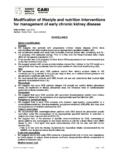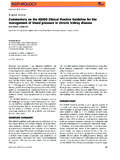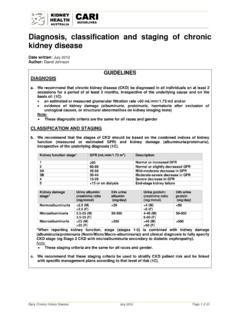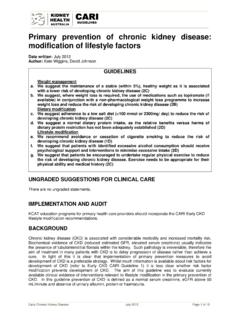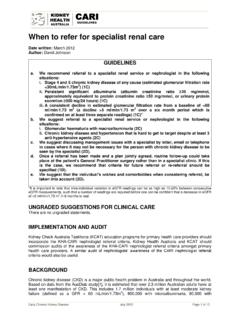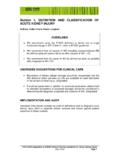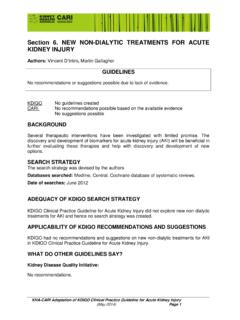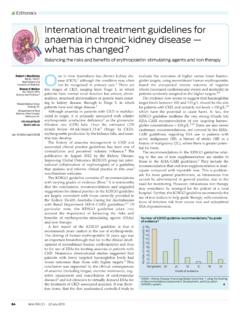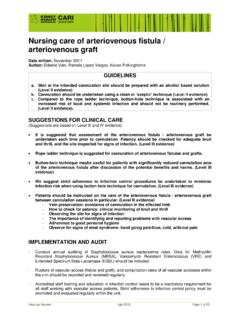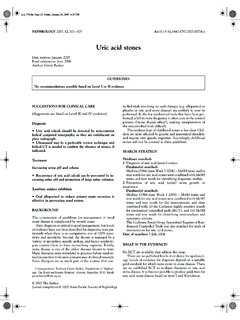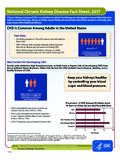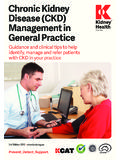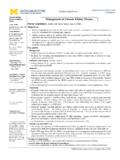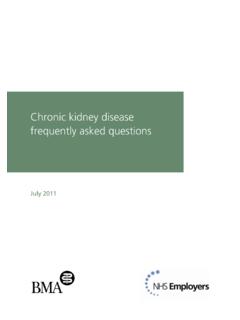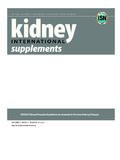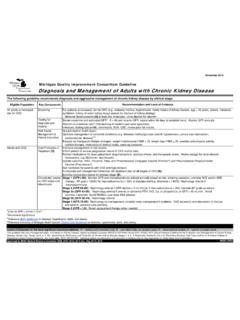Transcription of Primary prevention of chronic kidney disease: …
1 _____Early chronic kidney disease July 2012 Page 1 of 9 Primary prevention of chronic kidney disease : managing diabetes mellitus to reduce the risk of progression to CKD Date written: July 2012 Author: Kate Wiggins, Graeme Turner, David Johnson GUIDELINES We suggest that patients with diabetes mellitus aim to achieve an HbA1c < or <53 mmol/mol* (2B). * SI units recommended as per The International HbA1c Consensus Committee [1, 2] UNGRADED SUGGESTIONS FOR CLINICAL CARE There are no ungraded statements IMPLEMENTATION AND AUDIT KCAT education programs for Primary health care providers should incorporate the CARI Early CKD diabetes mellitus recommendations. Primary health care practitioners should regularly audit their practices to ascertain the proportion of their diabetic patient population that meets the KHA-CARI Early CKD Guideline HbA1c targets for Primary prevention of CKD. BACKGROUND diabetes mellitus (DM) is well-recognised as a risk factor for development of chronic kidney disease (CKD).
2 Furthermore, amongst patients with DM glycaemic control, most commonly assessed by measurement of the glycosylated haemoglobin (HbA1c) modulates the risk of developing diabetic nephropathy. In particular, elevated HbA1c levels increase the likelihood of renal disease . Several treatments for DM are available. These include oral hypoglycaemic agents (sulfonylureas, glitinides, metformin, glitazones, -glucosidase inhibitors), incretin enhancers and mimetics, and insulin. Available insulin preparations include very short-, short-, intermediate- and long-acting agents. While all diabetic treatments aim to reduce blood glucose levels they have a diverse range of mechanisms of action with potential benefits and harms that extend beyond their glucose lowering activity. These differences may translate into variable effects on clinical outcomes. In this Guideline the currently available evidence regarding the role of treatment of DM in Primary prevention of CKD is evaluated.
3 Particular emphasis is placed on the relationship between glycaemic control and development of CKD, and on benefits of specific treatment regimens. SEARCH STRATEGY Databases searched: Text words for chronic kidney disease were combined with MeSH terms and text words for diabetes mellitus . The search was carried out in Medline (1966 August 2009). No language restrictions were placed on the search. The conference proceedings of the American Society of _____ Early chronic kidney disease July 2012 Page 2 of 9 Nephrology from 1994-2008 were also searched for trials. Search update was carried out in Medline (2009 2012). Text words and MeSH terms for kidney disease and renal insufficiency were combined with text words and MeSH terms for diabetes mellitus and glycosylated haemoglobin. Date of search/es: August 2009; February 2012 WHAT IS THE EVIDENCE? The diabetes Control and Complications Trial (DCCT) was a multicentre, randomised trial comparing intensive versus conventional insulin therapy in 1441 patients with Type I DM (Insulin-requiring diabetes mellitus ; IDDM) [3].
4 The study population was divided into 2 cohorts, Primary prevention and secondary intervention. Inclusion criteria for the Primary prevention cohort were urinary albumin excretion (UAE) less than 40mg per 24 hours, IDDM for 1 to 5 years, and absence of retinopathy. A total of 726 patients met the inclusion criteria for Primary prevention , of which 378 were randomised to conventional therapy and 348 to intensive therapy. Baseline creatinine clearance was 127 28 vs 128 30 mL/min in the conventional and intensive therapy groups, respectively, and UAE 12 8 vs12 9 mg/24 hours. Patients in the Primary prevention cohort had a significantly lower HbA1c beyond baseline. The mean follow-up was years (range 3-9). The number of patients who developed microalbuminuria (defined by the authors as UAE 40mg/ 24 hours, measured annually) was less in the intensive therapy group (P< ); the mean adjusted risk of microalbuminuria was reduced by 34% (P= ). Amongst the secondary intervention cohort who had baseline AER <40mg/ 24 hours, intensive therapy reduced the adjusted mean risk of developing microalbuminuria by 43% (P= ).
5 In the entire study population advanced nephropathy (UAE 300mg/24 hours, creatinine clearance <70mL/ ) developed in 7 patients (2 in the intensive therapy and 5 in the conventional therapy group). Severe hypoglycaemic episodes were more common in the intensive therapy group. The Epidemiology of diabetes Interventions and Complications (EDIC) was a long-term follow-up study of a subgroup of participants in the DCCT [4]. The 1349 patients (688 and 687 in the former conventional and intensive treatment cohorts respectively) were followed for a further 7 or 8 years at completion of the DCCT. During the course of the EDIC study the mean HbA1c levels in the two cohorts approached each other but remained statistically different ( vs for the intensive and conventional groups respectively, P= ). In patients who had normoalbuminuria (AER <28 g/min or 40 mg/24 hours) at DCCT commencement and completion, of the former intensive therapy group developed microalbuminuria (AER >40mg/24 hours) compared to of the former conventional therapy group.
6 Albuminuria (AER >300mg/24 hours) developed in and of at-risk patients in the former intensive and conventional treatment cohorts by EDIC completion. An increase in the serum creatinine to above 2 mg/dL ( mol/L) occurred in of the intensive group and of the conventional group (P= ). Statistically significant differences in the mean serum creatinine throughout the EDIC study were also observed ( vs mg/dL ( vs mol/L), P< ). Despite more frequent hypoglycaemic episodes in the intensive treatment group there was no long-term effect on cognition [5]. The United Kingdom Prospective diabetes Study (UKPDS) was a randomised controlled trial conducted between 1977 and 1997 that compared conventional therapy (diet alone) with intensive therapy (insulin, glibenclamide, glipizide, metformin or chlorpropamide as monotherapy or combination therapy) in 3,867 patients with newly diagnosed type 2 diabetes [6, 7].
7 Median follow-up was years. Data was presented separately for intensive therapy with insulin, sulfonylureas or chlorpropamide versus conventional therapy, and metformin versus conventional therapy. The median HbA1c was for intensive therapy with insulin, chlorpropamide and sulfonylureas versus conventional therapy, and for metformin vs for the conventional group. Amongst a subgroup of patients treated with chlorpropamide, glibenclamide or insulin, (and conventional therapy controls) microalbuminuria was consistently more common in the conventional therapy group from 9 years onwards. No difference in microalbuminuria was seen between metformin and conventional therapy. There was no difference in the number of patients developing renal failure (dialysis or plasma creatinine > 250mol/L) or dying from renal disease either between conventional _____ Early chronic kidney disease July 2012 Page 3 of 9 and intensive therapy groups, or agents used in intensive therapy.
8 Hypoglycaemic episodes were more common in patients receiving intensive therapy. A cohort of 3227 patients entered a post-trial monitoring study. After 10 years of monitoring there was no difference in the urinary albumin: creatinine ratio between intensive and conventional treatment [8]. Plasma creatinine levels were 15% higher in patients treated with metformin than other groups. Sasaki and colleagues retrospectively evaluated risk factors for development of persistent microalbuminuria (2 consecutive positive tests for urine albumin (30 mg/dL) measured by Albustix in one year, in the absence of other renal disease ) in patients with Type 2 diabetes mellitus [9]. Patients were first seen in a Japanese medical clinic between 1960 and 1979, and followed until 1984 (average follow-up 10 years). In total 1196 patients (740 males, 456 females) were evaluated. The mean annual incidence rate of persistent microalbuminuria differed significantly according to the type of treatment patients were on at baseline ( vs vs for diet, oral hypoglycaemic agents and insulin respectively, P< ).
9 Treatment with insulin was an independent predictor for development of microalbuminuria on logistic regression analysis. Limitations of this study include the retrospective nature, and absence of information about glycaemic control other than fasting glucose at baseline. The study does not establish whether insulin therapy is associated with an increased risk of developing microalbuminuria because it is a surrogate marker of poor glycaemic control and/ or duration of DM. Applicability to current practice may be limited because this study was conducted in a Japanese population. SUMMARY OF EVIDENCE Despite the high risk of developing CKD in patients with DM and recommendations for good glycaemic control there is very little evidence regarding treatment of DM and prevention of CKD. Three studies have evaluated the relationship between diabetes management and prevention of CKD. The DCCT was a well-designed RCT involving a large number of patients.
10 It showed that intensive treatment with insulin reduced the risk of developing microalbuminuria, although the definition of microalbuminuria differed to the current NKF definition. This benefit was sustained in a further 7-8 years of follow-up despite convergence of HbA1c levels. The overall rate of microalbuminuria in the DCCT/ EDIC cohort was lower than in other reported series, possibly due to a Hawthorne effect. This may reduce the applicability of the results to other populations. The relationship between glycaemic control and patient outcomes in type 2 diabetics was studied in the UKPDS trial. Microalbuminuria was less common with intensive therapy with glibenclamide, chlorpropamide or insulin than with conventional therapy, but no difference was seen with metformin therapy. Although a sustained beneficial effect of intensive therapy on overall patient outcomes was seen with intensive therapy following trial completion, this was not the case with renal outcomes.
